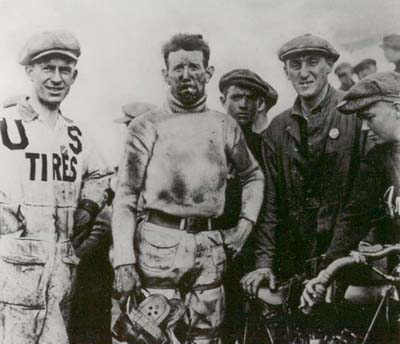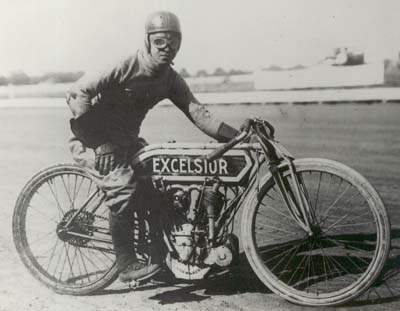by Daniel K. Statnekov |
| ©1998 - 2006 Daniel K. Statnekov |
After the H-D triumph at Dodge City, the Milwaukee company's competitors
fought back fiercely. In August, Earl "Red" Armstrong, Otto Walker's
pre-1914 barn-storming companion, rode an 8-valve Indian to victory in the
inaugural, 300-mile main event on the boards at the newly-completed
Tacoma, Washington motordrome. Along with his win in this important
race, Armstrong captured the world record for the 100, 200, and 300-mile
distance for his Springfield employer.
Armstrong's dashing victory ahead of Otto Walker and Don Johns (who was now riding for Indian) had the capacity crowd on its feet and in a frenzy for most of the race. In the closely contested finish, the winning Indian rider crossed the line only a wheel-length ahead of the Dodge City Champion and barely ahead of Johns, who early in the race had set a new world record for the 50-mile distance. Johns might have claimed victory for himself, but he broke two chains within the last 35 miles of the race. Nevertheless, his 3rd place finish along with Armstrong's win gave the Hendee company two of the top three spots along with bragging rights for four new world records. Indian's triumph over H-D and Excelsior restored a measure of pride to the loyal followers of the "Wigwam" (as the Springfield factory was fondly referred to by its riding public).
In September, Carl Goudy recaptured the glory for Excelsior, riding
perhaps the finest race of his career at the Maywood board track in
Chicago. Goudy's win on a Big Valve X shattered all existing
records for a 300-mile race, achieving an average speed of 85.8 mph.
His nearest competitor was 4 laps behind him at the finish.
Although this was a brilliant victory for Excelsior, the Chicago 300-miler also revealed the formidable speed of the new, Ottaway-improved H-D engine. During the race, Otto Walker set a new world record for the 100-mile distance, lapping the boards at an average speed of 89.11 mph before dropping out with mechanical problems. Importantly, Walker's record-setting ride was nearly 8 mph faster than the Indian mark set by Armstrong the previous month. Flush with their victory at Venice and Dodge City, but wary of their competitors success at Tacoma and Chicago, the Davidsons gave the go-ahead to Bill Ottaway to develop an even more advanced rendition of the Harley-Davidson engine that was tearing up the boards and bringing in the orders. Drawing upon recent advancements in aeronautical engine technology, Ottaway designed an 8-valve top-end to replace the standard pocket-valve configuration on his winning motor. The initial idea behind the four valve per cylinder design (that Hedstrom had pioneered for Indian in 1910) was not concerned with gaining horsepower, but rather to overcome the industry-wide problem of valve breakage. Exhaust valves, manufactured from early 20th Century steel, would not stand up to the extreme heat generated by racing temperatures. If a manufacturer could solve this problem, they would gain a decided advantage. Hedstrom's theory was that several smaller valves could better dissipate their heat with the result that a motor so constructed would run cooler, more likely to survive in the longer races. The Indian engineer's theory proved correct. When the Springfield company learned to adjust the valve timing to take advantage of the increased valve area, it was discovered that Hedstrom's 8-valve design had not only solved the heat problem, but was faster as well. Although similar to the Indian race motor, Ottaway's 8-valve, with its hemispherical combustion chambers, was technically superior to Hedstrom's 1910 design. The Harley-Davidson engineer, however, encountered several technical difficulties that he was unable to overcome; so he persuaded Walter Davidson to engage the famous English engine designer, Sir Harry Ricardo, to help him complete the new design. Within a few weeks of his arrival in Milwaukee, Sir Harry solved the problem with the cylinders, but the new H-D motor would not be entered in a major race until well into the 1916 season. Schwinn's Excelsior continued to post significant wins through the remainder of 1915. Following Goudy's 300-mile victory in September, Bob Perry won a One-Hour National Championship in October and then in November won again, this time a 100-miler in Phoenix where he set a record for the century on a circular flat track. Publicity for the Excelsior Company championed the fact that Perry had set the new record against serious competition mounted by Harley-Davidson, Indian, and the "speed demon" Cyclone. |
|
|
|
|
|
Webmaster: daniels@statnekov.com |
Page installed: Nov. 15, 1996 Page revised: June 28, 2003 |

